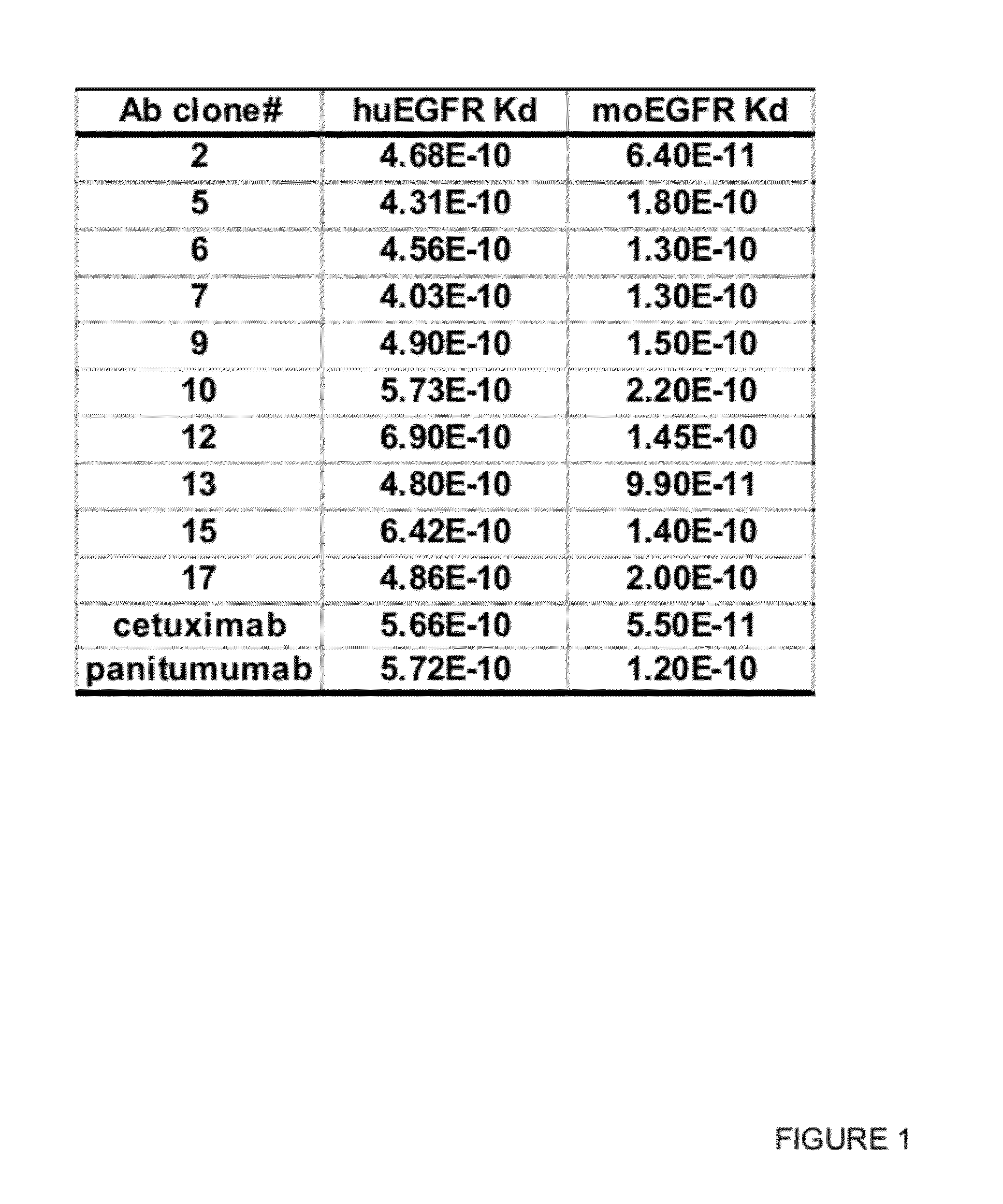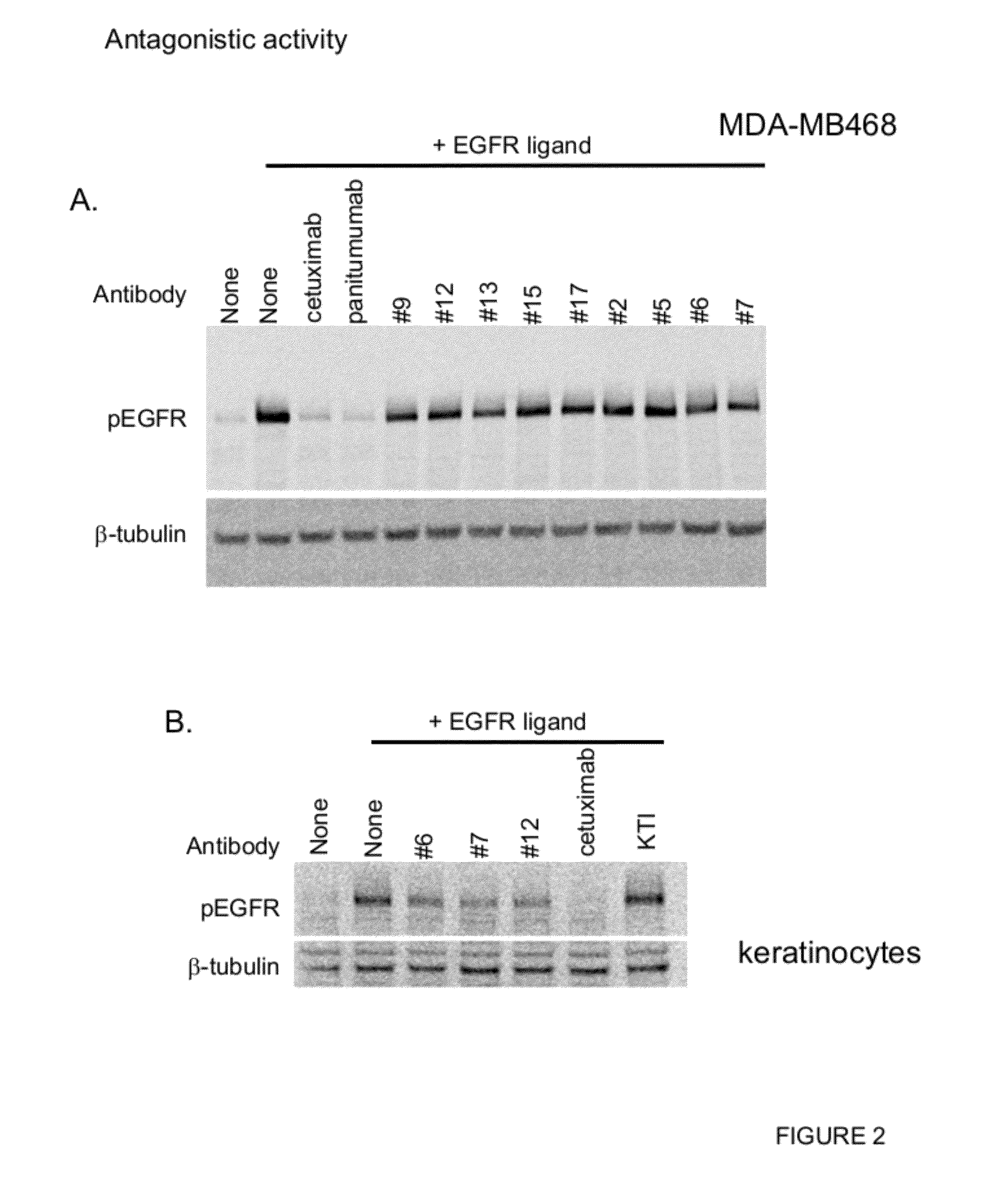Novel EGFR-Binding Molecules and Immunoconjugates Thereof
a technology of immunoconjugates and egfr, which is applied in the field of antibodies, antigen-binding fragments thereof, polypeptides, and immunoconjugates, can solve the problems of skin toxicity, decreased life quality of patients, and imperfect anti-egfr therapies
- Summary
- Abstract
- Description
- Claims
- Application Information
AI Technical Summary
Benefits of technology
Problems solved by technology
Method used
Image
Examples
example 1
[0259]Production of Murine EGFR Antibodies
[0260]To produce murine anti-EGFR antibodies, head and neck squamous carcinoma cell lines such as CA922 (Japanese Collection of Research Bioresources (JCRB), Shinjuku, Japan) and HSC4 (JCRB, Shinjuku, Japan) were injected subcutaneously into Balb / c female mice (Charles River Laboratory, Wilmington, Mass.) at the dose of 5×106 cells per mouse every 2 weeks for 5 times. Three days before being sacrificed for hybridoma generation, the immunized mice received intraperitoneal injection of another dose of antigen. The spleen from the mouse was collected according to standard animal protocols and was ground between two sterile, frosted microscopic slides to obtain a single cell suspension in RPMI-1640 medium. After the red blood cells were lysed with ACK lysing buffer, the spleen cells were then mixed with murine myeloma P3X63Ag8.653 cells (P3 cells) (J. F. Kearney et al. 1979, J Immunol, 123:1548-1550) at ratio of 1 P3 cells:3 spleen cells. The mi...
example 2
Binding Affinity to Human and Monkey EGFR Antigen
[0265]To determine the binding affinity of the EGFR antibodies to the human and monkey antigens, EGFR expressing human tumor cell lines such as MDA-MB468 (ATCC) and A431 (ATCC), and Vero monkey kidney cell line (ATCC) were used in a flow cytometric binding assay. In brief, the cells were incubated with various concentration of EGFR antibody for 1 h at 4° C. The cells were washed and incubated with PE-conjugated secondary antibody (Jackson Immunoresearch) for 1 h at 4° C. The cells were then washed, fixed in formalin and analyzed in FACSarray (BD Bioscience). To determine the binding affinity of these antibodies, geometric mean fluorescence intensity was plotted against the antibody concentration in a semi-log plot. A dose-response curve was generated by non-linear regression and the EC50 value of the curve, which corresponds to the apparent dissociation constant (Kd) of each antibody, was calculated using GraphPad Prism v4 (GraphPad s...
example 3
Inhibition of Ligand-Induced EGFR Activation
[0266]EGFR ligand binding induces EGFR phosphorylation followed by activation of downstream signaling pathways. To investigate the effect of anti-EGFR antibodies in ligand-induced EGFR activation, Western blot analysis was performed using MDA-MB468 tumor cell line and human primary adult keratinocytes. In brief, cells were seeded at 1e6 cells / well in a 6 well plate and cultured in normal media for overnight. Cells were washed and starved in serum free media containing 0.1% BSA for 2 hours at 37° C. 10 μg / ml antibody was added to the cells and the mixture was incubated for 3 hours at 37° C. 50 ng / ml EGF (R&D Systems) was added to the mixture and incubated for 15 minutes at 37° C. Cells were then washed with ice-cold PBS and lysed in RIPA buffer containing protease and phosphatase inhibitors. The protein lysates were separated in SDS-PAGE and transferred to a nitrocellulose membrane. The membrane was blocked with 5% BSA and incubated with an...
PUM
| Property | Measurement | Unit |
|---|---|---|
| dissociation constant | aaaaa | aaaaa |
| dissociation constant | aaaaa | aaaaa |
| dissociation constant | aaaaa | aaaaa |
Abstract
Description
Claims
Application Information
 Login to View More
Login to View More - R&D
- Intellectual Property
- Life Sciences
- Materials
- Tech Scout
- Unparalleled Data Quality
- Higher Quality Content
- 60% Fewer Hallucinations
Browse by: Latest US Patents, China's latest patents, Technical Efficacy Thesaurus, Application Domain, Technology Topic, Popular Technical Reports.
© 2025 PatSnap. All rights reserved.Legal|Privacy policy|Modern Slavery Act Transparency Statement|Sitemap|About US| Contact US: help@patsnap.com



